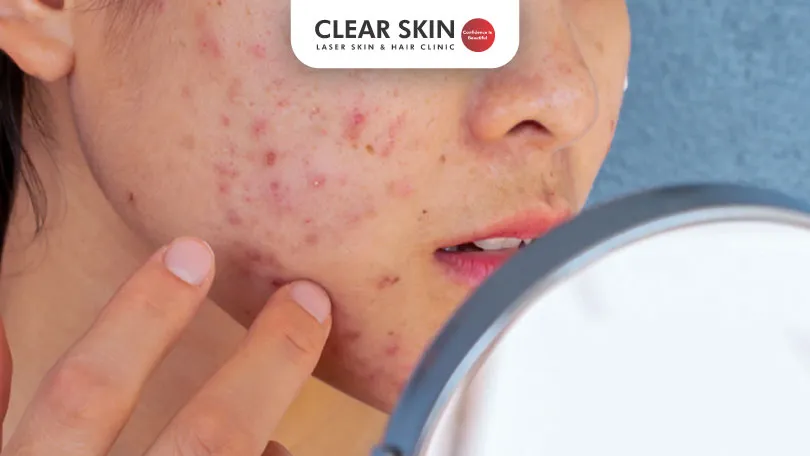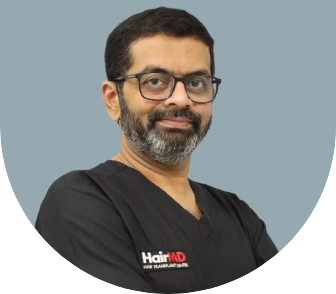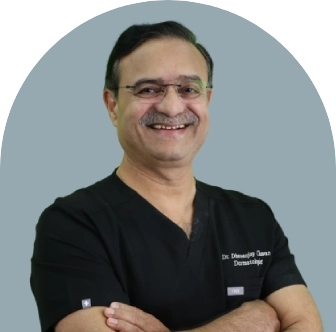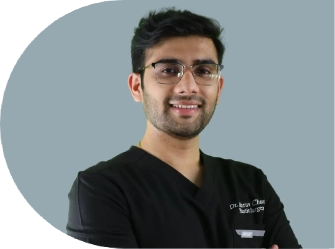What is Acne-Prone Skin? Understanding Causes & Treatments

Written by Clear Skin Content Team | Medically Reviewed by Dr. Dhanraj Chavan on September 02, 2023

In this definitive guide, we peel back the layers of acne to reveal the core issues at play, demystify common misconceptions, and equip you with the knowledge to take control of your skin’s destiny.
Acne has long been the bane of many people’s skincare regimen, from teenagers feeling the first pangs of self-consciousness to adults grappling with the unexpected return of pimples.
Understanding acne-prone skin is more than identifying occasional breakouts; it’s about comprehending the interplay of internal and external factors that create the perfect storm for eruptions.
In this definitive guide, we peel back the layers of acne to reveal the core issues at play, demystify common misconceptions, and equip you with the knowledge to take control of your skin’s destiny.
Table Of Content
- Understanding Acne-Prone Skin
- Factors Contributing to Acne-Prone Skin
- Identifying Acne-Prone Skin Characteristics
- Effective Acne Treatment Options
- Preventive Measures and Lifestyle Changes: Managing Acne Prone Skin
- Actionable Tips for a Personalized Skincare Routine
- conclusion
Understanding Acne-Prone Skin
The phrase ‘acne-prone skin’ often conjures images of severe breakouts and oily complexions. Still, it’s a more nuanced condition than it seems. Acne-prone skin is, put, more likely to develop acne due to a combination of genetic, hormonal, and environmental factors. It’s a prevalent issue affecting a staggering number of people globally, yet it can still feel incredibly isolating.
Debunking Myths about Acne
One of the most crucial steps to understanding acne-prone skin is deboning the numerous myths surrounding it. From the notion that only teenagers suffer from acne to the idea that washing your face more frequently will prevent breakouts, these misconceptions can lead to ineffective treatments and a misinformed approach.
What causes Acne Instead?
Acne is not just about clogged pores; it’s an inflammatory condition caused by the overproduction of sebum, the oil naturally secreted by our skin, combined with a bacteria called Propionibacterium acnes. These factors and a host of others that we’ll explore, contribute to forming those unwelcome pimples.
Factors Contributing to Acne-Prone Skin
The road to acne-prone skin can be as personal as it is complex. Here, we dissect the main culprits, shedding light on the more subtle influences that could be tipping your skin towards eruption.
- Environmental Factors
Our skin is our first line of defense against the environment, and it does not always win the battle unscathed. Pollution and humidity can exacerbate acne, complicating our skin’s natural balance and protective capabilities.
- The Hormones
Hormones play a pivotal role, particularly in the chronicles of teenage acne. But even beyond adolescence, hormonal fluctuations and hormonal hypersensitivity can influence the sebaceous glands’ activity, making acne an issue for people of all ages.
- Genetics
Your genetic makeup is like a blueprint for your skin, and when it comes to acne, it often spells out a propensity for breakouts. While not a determinant, genes can certainly stack the odds against clear skin.
- Dietary Choices
It’s true; what you eat can influence your skin. While no food directly causes acne, certain foods such as processed, sugary, or greasy foods may aggravate inflammation and sebum production.
- Medication and Stress
Certain medications, like corticosteroids and lithium, can lead to acne flare-ups as a side effect. Conversely, stress can disrupt hormone balance, increase skin inflammation, and aggravate breakouts.
- Skincare Habits
Skincare products are designed to help our skin, but some could actually make matters worse. Overusing exfoliants or stripping cleansers can irritate your skin and lead to more acne.
While some factors may be out of our control, we can take steps to minimize their impact on acne-prone skin. Making healthy dietary choices, managing stress levels, and choosing skincare products carefully can all contribute to clearer skin. It’s important to remember that no one factor is solely responsible for acne; it’s often a combination of factors working together.
How to choose the right Skincare Products ? | Clear Skin, Pune
Identifying Acne-Prone Skin Characteristics
Recognizing the signs of acne-prone skin is the first step to managing it effectively. Here’s how to distinguish between normal skin health and the beginnings of a potential acne storm.
- Excess Sebum Production
Acne-prone skin tends to produce more sebum (oil) than normal skin. This excess oil can clog pores, leading to blackheads and whiteheads, or create the perfect breeding ground for bacteria that cause inflammatory acne. If your skin looks shinier than usual, it’s a sign of increased sebum production.
- Frequent Breakouts
While occasional breakouts may be normal, frequent and recurring ones indicate acne-prone skin. These breakouts can occur in various forms, such as blackheads, whiteheads, papules, pustules, or nodules. Some people may also experience cystic acne, which consists of large, painful bumps beneath the skin.
If you notice a pattern of recurrent breakouts, your skin is likely prone to acne.
- Inflammation and Redness
Inflammatory acne is characterized by redness and swelling around the affected area. This type of acne occurs when bacteria enter clogged pores, causing an immune response from the body. The result is often angry-looking pimples that can be painful to touch.
Keep an eye out for any blotchy or irritated areas on your skin, as this can indicate that you have acne-prone skin.
- Sensitivity and Irritation
Acne-prone skin is often more sensitive and easily irritated compared to normal skin. Certain skincare products or environmental factors can cause flare-ups or worsen existing breakouts. If you notice your skin becoming red, itchy, or dry after using certain products, it could indicate that it is prone to acne.
Be mindful of the ingredients in your skincare routine, and make note of any triggers that may irritate.
- Scarring and Hyperpigmentation
One of the most frustrating aspects of dealing with acne-prone skin is the risk of scarring and hyperpigmentation. As pimples heal, they can leave behind dark spots or uneven skin tone. Severe acne may also result in permanent scarring, which can be challenging to treat.
To prevent scarring and hyperpigmentation, it’s essential to treat and manage breakouts as soon as they occur properly. This includes avoiding picking or popping pimples and using gentle skincare products. In some cases, professional treatments such as chemical peels or laser therapy may be necessary to reduce the appearance of scarring.
Effective Acne Treatment Options
The good news is that many avenues for treating acne exist. The challenge lies in finding the most effective approach for you and having the patience and consistency to see it through.
1.Topical Treatments
Topical treatments are products applied directly to the skin, such as creams, gels, or lotions. These can contain active ingredients like benzoyl peroxide, salicylic acid, or retinoids, which work to unclog pores and reduce inflammation.
It’s important to note that everyone’s skin is different, so what works for one person may not work for another. It’s common to experience some initial dryness or irritation when using topical treatments, so it’s best to start with a small amount and gradually increase usage if your skin can tolerate it.
2.Oral Medications
In more severe cases of acne, a dermatologist may prescribe oral medications. These can include antibiotics, hormonal treatments, or isotretinoin, a powerful medication that targets multiple factors contributing to acne.
Oral medications may have more potential side effects than topical treatments, so it’s important to monitor and communicate with your doctor closely. They can also take longer to see results, but they may be the most effective option for some people.
3.Treatments at dermatology Clinics
For individuals seeking advanced solutions, dermatology clinics offer a range of professional treatments for acne that can be quicker and more effective for certain skin types.
- Chemical Peels
These involve the application of a chemical solution to the skin, which exfoliates the surface and can help reduce the appearance of acne scars. Chemical peels vary in strength and must be selected based on the individual’s skin type and acne severity.
- Laser Therapy
Laser therapy uses focused light to target and improve the skin’s appearance. It can reduce acne bacteria, shrink oil glands, and help repair scar tissue. Laser treatments can be especially beneficial for reducing the visibility of acne scars.
- Microdermabrasion
This is a minimally invasive procedure that uses a special applicator with an abrasive surface to gently sand away the thick outer layer of the skin to rejuvenate it. It’s particularly useful for treating superficial acne scars and can help to unclog pores, preventing new breakouts.
- Light Therapy
Blue and red light therapies are non-invasive treatments that use light to kill acne-causing bacteria on the skin and reduce inflammation. These treatments can be a good option for people who are sensitive to topical treatments or antibiotics.
- Extraction Procedures
Dermatologists may perform extraction procedures to remove whiteheads and blackheads that clog pores. While potentially effective, these procedures carry a risk of scarring and infection if not done properly.
It’s important to consult with a dermatologist to determine the most appropriate treatment plan based on your specific condition and skin type. Each treatment has its own set of benefits and potential side effects, making it crucial to tailor the approach to each individual’s needs.
- Lifestyle Changes
In addition to topical treatments and medications, simple lifestyle changes can make a big difference in managing acne. These include:
- Washing your face twice a day with a gentle cleanser
- Avoiding picking or popping pimples
- Using oil-free and non-comedogenic skincare products
- Managing stress levels through exercise, meditation, or other relaxation techniques
- Eating a healthy diet rich in fruits, vegetables, and whole grains
- Staying hydrated by drinking plenty of water
There are various options for managing acne, depending on the severity and individual preferences. It’s important to consult with a dermatologist at Clear Skin Clinic to determine the best course of treatment for your specific case.
Preventive Measures and Lifestyle Changes: Managing Acne Prone Skin
Acne treatment isn’t just about what you put on your face; it’s about the holistic picture. Lifestyle changes can play a massive role in controlling and preventing acne.
Here are some preventive measures and lifestyle changes that can help manage acne-prone skin:
- Skincare Routine
Establishing a proper skincare routine is essential for managing acne. This includes washing your face twice daily with a gentle cleanser, using oil-free and non-comedogenic products, and avoiding harsh or abrasive scrubs. Removing makeup before bed and regularly cleaning your makeup brushes is also important.
- Diet
While there is no specific diet that has been proven to treat acne, some foods may trigger flare-ups in certain individuals. It’s important to pay attention to your body and identify any potential triggers for your acne. Some common culprits include dairy, high glycemic index foods, and processed sugars.
- Stress Management
Stress can exacerbate acne, so finding ways to manage stress levels is crucial. This can include exercise, meditation, yoga, or other relaxation techniques. Getting enough sleep and taking breaks when needed can also help reduce stress levels.
- Hydration
Proper hydration is essential for overall skin health and managing acne. Drinking plenty of water helps flush out toxins. It keeps the skin hydrated, preventing excess oil production that can lead to acne.
- Regular Exercise
Regular exercise helps manage stress and improves blood circulation and oxygen flow to the skin, which can help keep it healthy and clear. However, be mindful of showering or cleansing your face after exercising, as sweat can clog pores.
- Avoid Touching Your Face
Avoid touching your face throughout the day, as this can transfer bacteria and oils from your hands to your skin, potentially leading to breakouts. If you do need to touch your face, make sure to wash your hands beforehand.
- Consult a Dermatologist
Suppose over-the-counter products and lifestyle changes are not effectively managing your acne. In that case, it may be time to consult a dermatologist in Pune. They can provide personalized treatment plans and prescribe medication to help control your acne.
While managing acne can be frustrating, it’s important to remember that everyone’s skin is unique, and what works for one person may not work for another. It’s essential to listen to your body, make necessary lifestyle changes, and consult a dermatologist.
Actionable Tips for a Personalized Skincare Routine
Step 1 : Cleanse
Step 2 : Treat
Step 3: Moisturize
Step 4: Protect
Step 5: Assess Regularly
Do You Know?
Roughly 250 Patients Are Treated
Everyday By These Dermatologists
(You are one click away from flawless skin)
Meet Our Dermatologist!
Conclusion
Further Reading
Pune Acne Treatment Reviews – What Real Patients Say About Clear Skin Clinic?
Clear Skin Clinic Pune reviews: 4.9/5 stars across 13,271+ verified reviews. Real patient experiences, treatment timelines & acne success stories.
The Top Benefits of IV Drip Therapy
IV drip therapy delivers vitamins and fluids directly into the bloodstream. Know its benefits for energy, immunity, hydration, and skin health.
IV Drip Therapy in Pune & PCMC: How It Works
Discover how to combat dry skin acne & achieve radiant skin. Expert skincare tips to hydrate & prevent breakouts. Visit Clear Skin Clinics Pune for solutions.
Dry Skin and Acne
Discover how to combat dry skin acne & achieve radiant skin. Expert skincare tips to hydrate & prevent breakouts. Visit Clear Skin Clinics Pune for solutions.
Have thoughts? Please let us know
We are committed not only to treating you, but also educating you.





